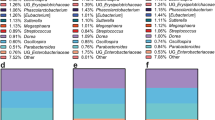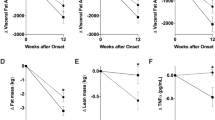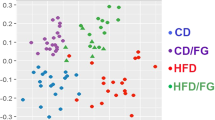Abstract
Background/Objectives:
The intestinal microbiota may have a profound impact on host metabolism. As evidence suggests that polyphenols affect substrate utilization, the present study aimed to investigate the effects of polyphenol supplementation on intestinal microbiota composition in humans. Furthermore, we examined whether (changes in) gut microbiota composition may determine the metabolic response to polyphenol supplementation.
Subjects/Methods:
In this randomized, double-blind, placebo (PLA)-controlled trial, 37 overweight and obese men and women (18 males/19 females, 37.8±1.6 years, body mass index: 29.6±0.5 kg/m2) received either epigallocatechin-3-gallate and resveratrol (EGCG+RES, 282 and 80 mg/day, respectively) or PLA for 12 weeks. Before and after intervention, feces samples were collected to determine microbiota composition. Fat oxidation was assessed by indirect calorimetry during a high-fat mixed meal test (2.6 MJ, 61 energy% fat) and skeletal muscle mitochondrial oxidative capacity by means of ex vivo respirometry on isolated skeletal muscle fibers. Body composition was measured by dual-energy X-ray absorptiometry.
Results:
Fecal abundance of Bacteroidetes was higher in men as compared with women, whereas other assessed bacterial taxa were comparable. EGCG+RES supplementation significantly decreased Bacteroidetes and tended to reduce Faecalibacterium prausnitzii in men (P=0.05 and P=0.10, respectively) but not in women (P=0.15 and P=0.77, respectively). Strikingly, baseline Bacteroidetes abundance was predictive for the EGCG+RES-induced increase in fat oxidation in men but not in women. Other bacterial genera and species were not affected by EGCG+RES supplementation.
Conclusions:
We demonstrated that 12-week EGCG+RES supplementation affected the gut microbiota composition in men but not in women. Baseline microbiota composition determined the increase in fat oxidation after EGCG+RES supplementation in men.
This is a preview of subscription content, access via your institution
Access options
Subscribe to this journal
Receive 12 print issues and online access
$259.00 per year
only $21.58 per issue
Buy this article
- Purchase on Springer Link
- Instant access to full article PDF
Prices may be subject to local taxes which are calculated during checkout

Similar content being viewed by others

References
Clemente JC, Ursell LK, Parfrey LW, Knight R . The impact of the gut microbiota on human health: an integrative view. Cell 2012; 148: 1258–1270.
Vrieze A, Out C, Fuentes S, Jonker L, Reuling I, Kootte RS et al. Impact of oral vancomycin on gut microbiota, bile acid metabolism, and insulin sensitivity. J Hepatol 2014; 60: 824–831.
Vrieze A, Van Nood E, Holleman F, Salojarvi J, Kootte RS, Bartelsman JF et al. Transfer of intestinal microbiota from lean donors increases insulin sensitivity in individuals with metabolic syndrome. Gastroenterology 2012; 143: 913–916.e7.
Bolnick DI, Snowberg LK, Hirsch PE, Lauber CL, Org E, Parks B et al. Individual diet has sex-dependent effects on vertebrate gut microbiota. Nat Commun 2014; 5: 4500.
Wu GD, Chen J, Hoffmann C, Bittinger K, Chen YY, Keilbaugh SA et al. Linking long-term dietary patterns with gut microbial enterotypes. Science 2011; 334: 105–108.
Chandalia M, Garg A, Lutjohann D, von Bergmann K, Grundy SM, Brinkley LJ . Beneficial effects of high dietary fiber intake in patients with type 2 diabetes mellitus. N Engl J Med 2000; 342: 1392–1398.
Bogdanski P, Suliburska J, Szulinska M, Stepien M, Pupek-Musialik D, Jablecka A . Green tea extract reduces blood pressure, inflammatory biomarkers, and oxidative stress and improves parameters associated with insulin resistance in obese, hypertensive patients. Nutr Res 2012; 32: 421–427.
Most J, Goossens GH, Jocken JW, Blaak EE . Short-term supplementation with a specific combination of dietary polyphenols increases energy expenditure and alters substrate metabolism in overweight subjects. Int J Obes (Lond) 2014; 38: 698–706.
Timmers S, Konings E, Bilet L, Houtkooper RH, van de Weijer T, Goossens GH et al. Calorie restriction-like effects of 30 days of resveratrol supplementation on energy metabolism and metabolic profile in obese humans. Cell Metab 2011; 14: 612–622.
Most J, Timmers S, Warnke I, Jocken JW, van Boekschoten M, de Groot P et al. Combined epigallocatechin-3-gallate and resveratrol supplementation for 12 wk increases mitochondrial capacity and fat oxidation, but not insulin sensitivity, in obese humans: a randomized controlled trial. Am J Clin Nutr 2016; 104: 215–227.
Qiao Y, Sun J, Xia S, Tang X, Shi Y, Le G . Effects of resveratrol on gut microbiota and fat storage in a mouse model with high-fat-induced obesity. Food Funct 2014; 5: 1241–1249.
Anhe FF, Roy D, Pilon G, Dudonne S, Matamoros S, Varin TV et al. A polyphenol-rich cranberry extract protects from diet-induced obesity, insulin resistance and intestinal inflammation in association with increased Akkermansia spp. population in the gut microbiota of mice. Gut 2015; 64: 872–883.
Roopchand DE, Carmody RN, Kuhn P, Moskal K, Rojas-Silva P, Turnbaugh PJ et al. Dietary polyphenols promote growth of the gut bacterium Akkermansia muciniphila and attenuate high fat diet-induced metabolic syndrome. Diabetes 2015; 64: 2847–2858.
Dao TM, Waget A, Klopp P, Serino M, Vachoux C, Pechere L et al. Resveratrol increases glucose induced GLP-1 secretion in mice: a mechanism which contributes to the glycemic control. PLoS One 2011; 6: e20700.
Brown AL, Lane J, Holyoak C, Nicol B, Mayes AE, Dadd T . Health effects of green tea catechins in overweight and obese men: a randomised controlled cross-over trial. Br J Nutr 2011; 106: 1880–1889.
Tomas-Barberan FA, Selma MV, Espin JC . Interactions of gut microbiota with dietary polyphenols and consequences to human health. Curr Opin Clin Nutr Metab Care 2016; 19: 471–476.
Duenas M, Munoz-Gonzalez I, Cueva C, Jimenez-Giron A, Sanchez-Patan F, Santos-Buelga C et al. A survey of modulation of gut microbiota by dietary polyphenols. Biomed Res Int 2015; 2015: 850902.
Queipo-Ortuno MI, Boto-Ordonez M, Murri M, Gomez-Zumaquero JM, Clemente-Postigo M, Estruch R et al. Influence of red wine polyphenols and ethanol on the gut microbiota ecology and biochemical biomarkers. Am J Clin Nutr 2012; 95: 1323–1334.
Tedjo DI, Jonkers DM, Savelkoul PH, Masclee AA, van Best N, Pierik MJ et al. The effect of sampling and storage on the fecal microbiota composition in healthy and diseased subjects. PLoS One 2015; 10: e0126685.
Bacchetti De Gregoris T, Aldred N, Clare AS, Burgess JG . Improvement of phylum- and class-specific primers for real-time PCR quantification of bacterial taxa. J Microbiol Methods 2011; 86: 351–356.
Rinttila T, Kassinen A, Malinen E, Krogius L, Palva A . Development of an extensive set of 16S rDNA-targeted primers for quantification of pathogenic and indigenous bacteria in faecal samples by real-time PCR. J Appl Microbiol 2004; 97: 1166–1177.
Gagen EJ, Denman SE, Padmanabha J, Zadbuke S, Al Jassim R, Morrison M et al. Functional gene analysis suggests different acetogen populations in the bovine rumen and tammar wallaby forestomach. Appl Environ Microbiol 2010; 76: 7785–7795.
Wang RF, Cao WW, Cerniglia CE . PCR detection and quantitation of predominant anaerobic bacteria in human and animal fecal samples. Appl Environ Microbiol 1996; 62: 1242–1247.
Collado MC, Derrien M, Isolauri E, de Vos WM, Salminen S . Intestinal integrity and Akkermansia muciniphila, a mucin-degrading member of the intestinal microbiota present in infants, adults, and the elderly. Appl Environ Microbiol 2007; 73: 7767–7770.
Armougom F, Henry M, Vialettes B, Raccah D, Raoult D . Monitoring bacterial community of human gut microbiota reveals an increase in Lactobacillus in obese patients and Methanogens in anorexic patients. PLoS One 2009; 4: e7125.
Phielix E, Schrauwen-Hinderling VB, Mensink M, Lenaers E, Meex R, Hoeks J et al. Lower intrinsic ADP-stimulated mitochondrial respiration underlies in vivo mitochondrial dysfunction in muscle of male type 2 diabetic patients. Diabetes 2008; 57: 2943–2949.
Cardona F, Andres-Lacueva C, Tulipani S, Tinahones FJ, Queipo-Ortuno MI . Benefits of polyphenols on gut microbiota and implications in human health. J Nutr Biochem 2013; 24: 1415–1422.
Dominianni C, Sinha R, Goedert JJ, Pei Z, Yang L, Hayes RB et al. Sex, body mass index, and dietary fiber intake influence the human gut microbiome. PLoS One 2015; 10: e0124599.
Flores R, Shi J, Fuhrman B, Xu X, Veenstra TD, Gail MH et al. Fecal microbial determinants of fecal and systemic estrogens and estrogen metabolites: a cross-sectional study. J Transl Med 2012; 10: 253.
Markle JG, Frank DN, Mortin-Toth S, Robertson CE, Feazel LM, Rolle-Kampczyk U et al. Sex differences in the gut microbiome drive hormone-dependent regulation of autoimmunity. Science 2013; 339: 1084–1088.
Cho I, Blaser MJ . The human microbiome: at the interface of health and disease. Nat Rev Genet 2012; 13: 260–270.
Tyakht AV, Kostryukova ES, Popenko AS, Belenikin MS, Pavlenko AV, Larin AK et al. Human gut microbiota community structures in urban and rural populations in Russia. Nat Commun 2013; 4: 2469.
Zarrinpar A, Chaix A, Yooseph S, Panda S . Diet and feeding pattern affect the diurnal dynamics of the gut microbiome. Cell Metab 2014; 20: 1006–1017.
Marin L, Miguelez EM, Villar CJ, Lombo F . Bioavailability of dietary polyphenols and gut microbiota metabolism: antimicrobial properties. Biomed Res Int 2015; 2015: 905215.
Monagas M, Urpi-Sarda M, Sanchez-Patan F, Llorach R, Garrido I, Gomez-Cordoves C et al. Insights into the metabolism and microbial biotransformation of dietary flavan-3-ols and the bioactivity of their metabolites. Food Funct 2010; 1: 233–253.
Ley RE, Turnbaugh PJ, Klein S, Gordon JI . Microbial ecology: human gut microbes associated with obesity. Nature 2006; 444: 1022–1023.
Dall'Asta M, Calani L, Tedeschi M, Jechiu L, Brighenti F, Del Rio D . Identification of microbial metabolites derived from in vitro fecal fermentation of different polyphenolic food sources. Nutrition 2012; 28: 197–203.
Bode LM, Bunzel D, Huch M, Cho GS, Ruhland D, Bunzel M et al. In vivo and in vitro metabolism of trans-resveratrol by human gut microbiota. Am J Clin Nutr 2013; 97: 295–309.
Calamini B, Ratia K, Malkowski MG, Cuendet M, Pezzuto JM, Santarsiero BD et al. Pleiotropic mechanisms facilitated by resveratrol and its metabolites. Biochem J 2010; 429: 273–282.
Lambert JD, Sang S, Yang CS . Biotransformation of green tea polyphenols and the biological activities of those metabolites. Mol Pharm 2007; 4: 819–825.
Mahowald MA, Rey FE, Seedorf H, Turnbaugh PJ, Fulton RS, Wollam A et al. Characterizing a model human gut microbiota composed of members of its two dominant bacterial phyla. Proc Natl Acad Sci USA 2009; 106: 5859–5864.
Timmers S, Hesselink MK, Schrauwen P . Therapeutic potential of resveratrol in obesity and type 2 diabetes: new avenues for health benefits? Ann NY Acad Sci 2013; 1290: 83–89.
Kang C, Zhang Y, Zhu X, Liu K, Wang X, Chen M et al. Healthy subjects differentially respond to dietary capsaicin correlating with the specific gut enterotypes. J Clin Endocrinol Metab 2016; 101: 4681–4689.
Larsen N, Vogensen FK, van den Berg FW, Nielsen DS, Andreasen AS, Pedersen BK et al. Gut microbiota in human adults with type 2 diabetes differs from non-diabetic adults. PLoS One 2010; 5: e9085.
Fernandes J, Su W, Rahat-Rozenbloom S, Wolever TM, Comelli EM . Adiposity, gut microbiota and faecal short chain fatty acids are linked in adult humans. Nutr Diabetes 2014; 4: e121.
Canfora EE, van der Beek CM, Goossens GH, Jocken JW, Lenaerts K, Holst JJ et al. Colonic short-chain fatty acids infusions promote fat oxidation and improve metabolic parameters in overweight males. Obes Facts 2015; 8: Abstract.
Perseghin G, Scifo P, Pagliato E, Battezzati A, Benedini S, Soldini L et al. Gender factors affect fatty acids-induced insulin resistance in nonobese humans: effects of oral steroidal contraception. J Clin Endocrinol Metab 2001; 86: 3188–3196.
van de Wijgert JH, Verwijs MC, Turner AN, Morrison CS . Hormonal contraception decreases bacterial vaginosis but oral contraception may increase candidiasis: implications for HIV transmission. Aids 2013; 27: 2141–2153.
Karlsson F, Tremaroli V, Nielsen J, Backhed F . Assessing the human gut microbiota in metabolic diseases. Diabetes 2013; 62: 3341–3349.
Arumugam M, Raes J, Pelletier E, Le Paslier D, Yamada T, Mende DR et al. Enterotypes of the human gut microbiome. Nature 2011; 473: 174–180.
Acknowledgements
We thank the study participants and Pure Encapsulations Inc. for provision of the supplements. This study was funded by the ALPRO foundation.
Author contributions
JM, GHG and EEB designed the study. JM performed the experiments and analyzed the data. JM wrote the manuscript. JM, JP, ML, GHG and EEB revised the content of the manuscript and approved the manuscript for publication.
Author information
Authors and Affiliations
Corresponding author
Ethics declarations
Competing interests
The authors declare no conflict of interest.
Rights and permissions
About this article
Cite this article
Most, J., Penders, J., Lucchesi, M. et al. Gut microbiota composition in relation to the metabolic response to 12-week combined polyphenol supplementation in overweight men and women. Eur J Clin Nutr 71, 1040–1045 (2017). https://doi.org/10.1038/ejcn.2017.89
Received:
Revised:
Accepted:
Published:
Issue Date:
DOI: https://doi.org/10.1038/ejcn.2017.89
This article is cited by
-
Gut microbiota-mediated associations of green tea and catechin intakes with glucose metabolism in individuals without type 2 diabetes mellitus: a four-season observational study with mediation analysis
Archives of Microbiology (2023)
-
Ketogenic diet for mood disorders from animal models to clinical application
Journal of Neural Transmission (2023)
-
The effects of synbiotic and/or vitamin D supplementation on gut-muscle axis in overweight and obese women: a study protocol for a double-blind, randomized, placebo-controlled trial
Trials (2022)
-
Phenolic Compounds Promote Diversity of Gut Microbiota and Maintain Colonic Health
Digestive Diseases and Sciences (2021)
-
Diets naturally rich in polyphenols and/or long-chain n-3 polyunsaturated fatty acids differently affect microbiota composition in high-cardiometabolic-risk individuals
Acta Diabetologica (2020)


